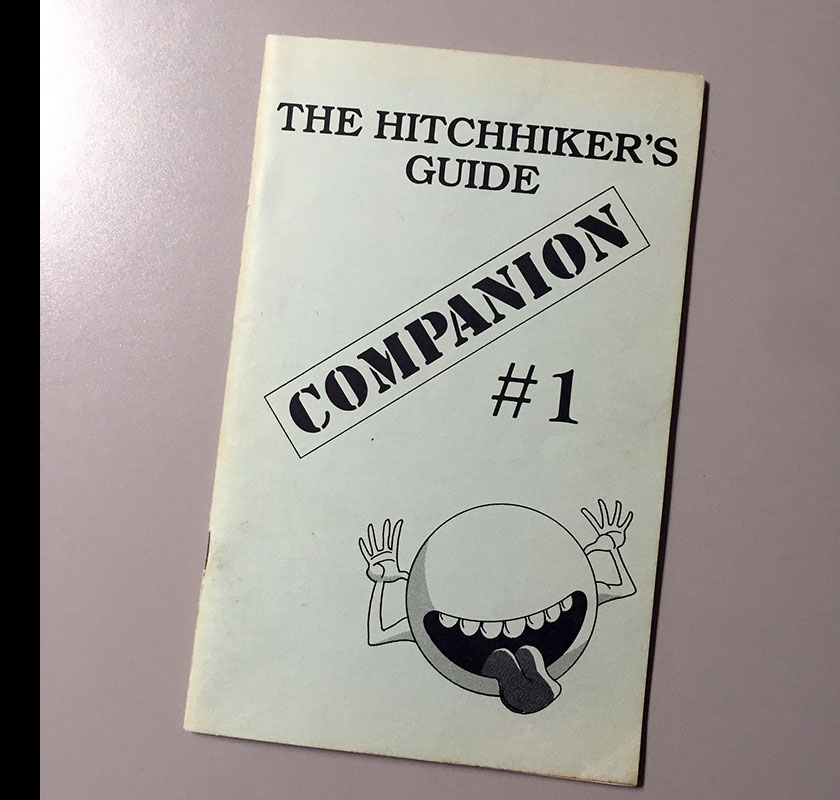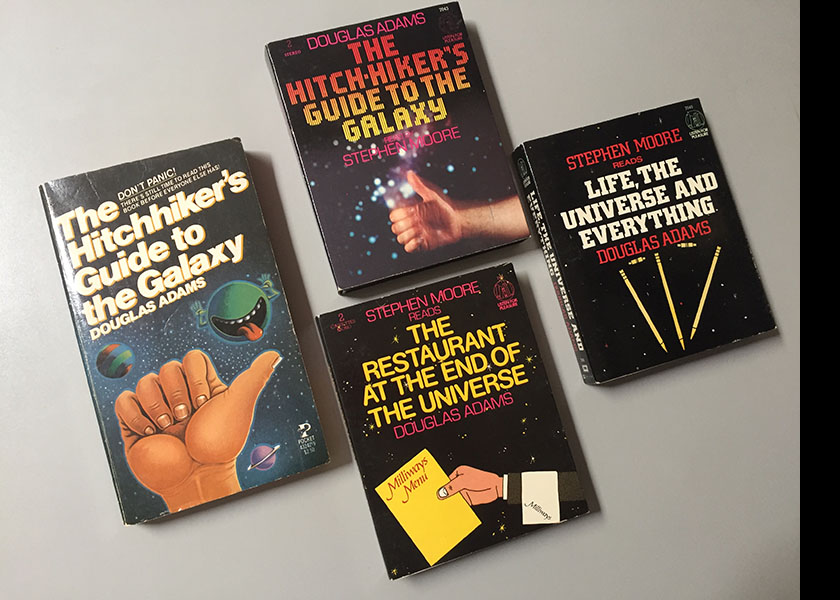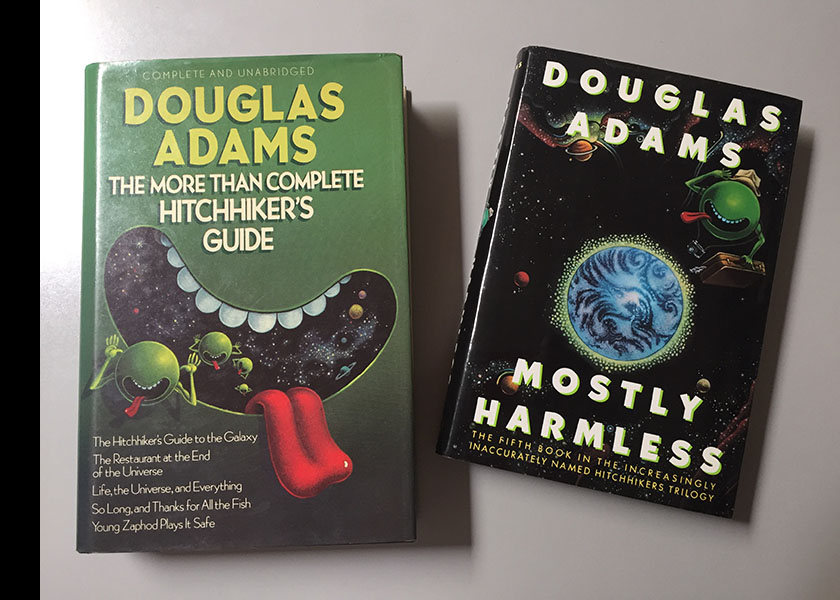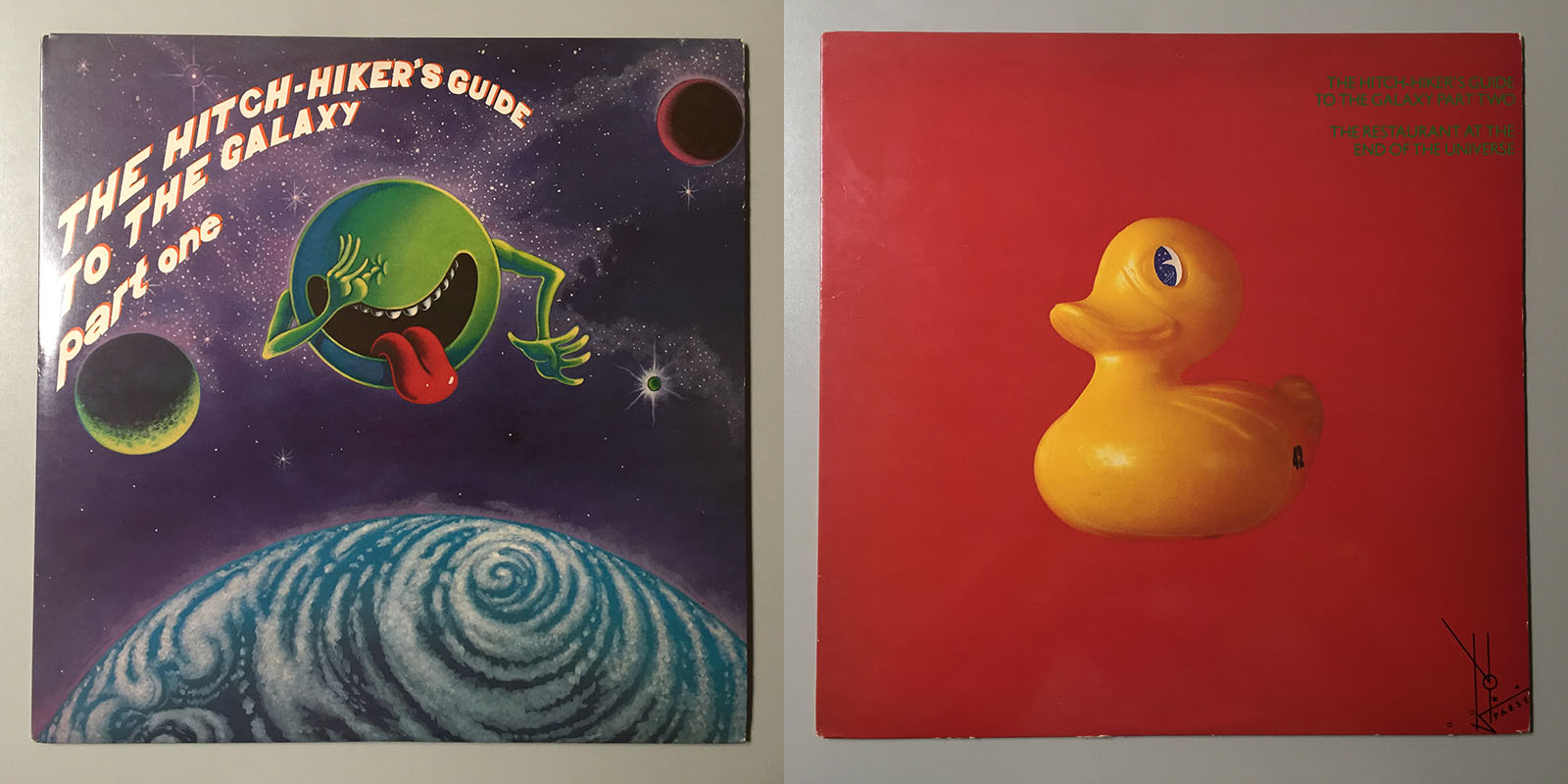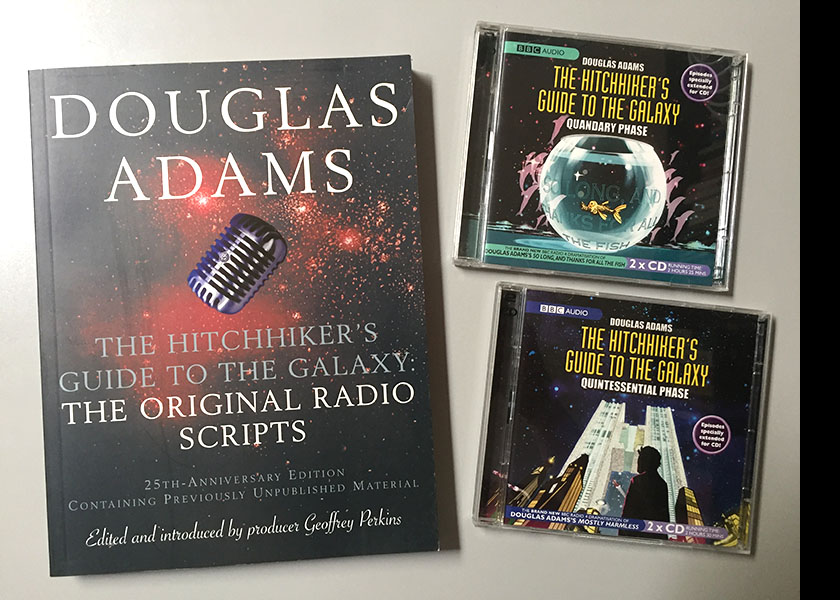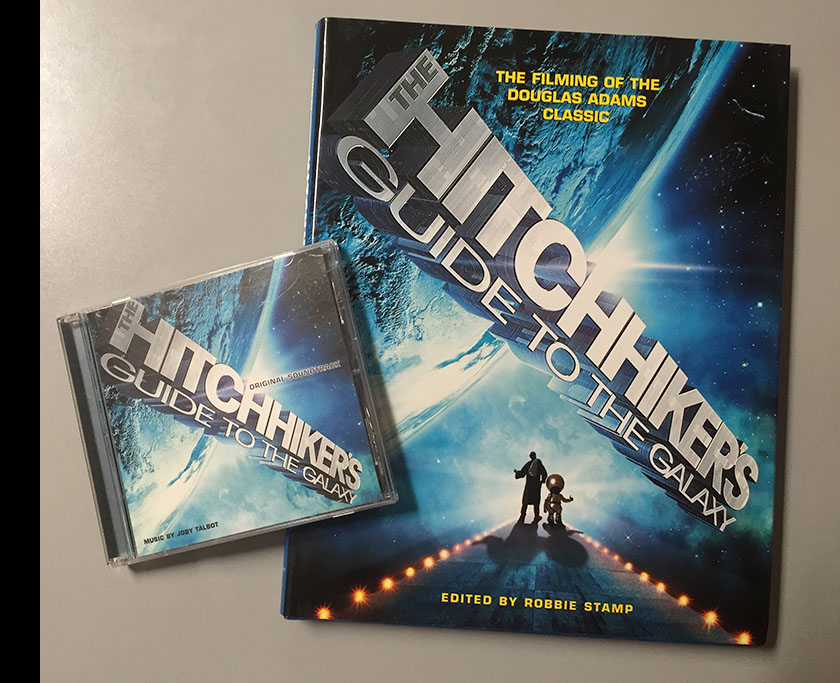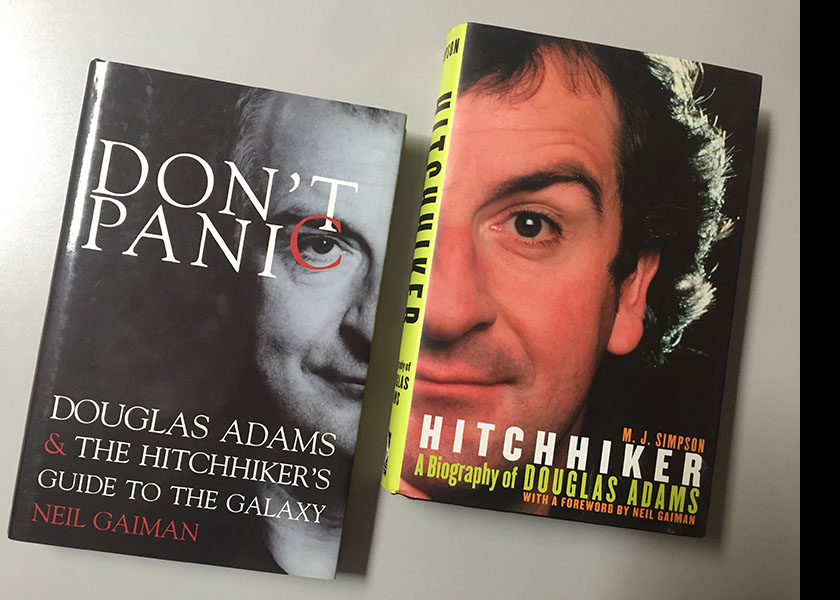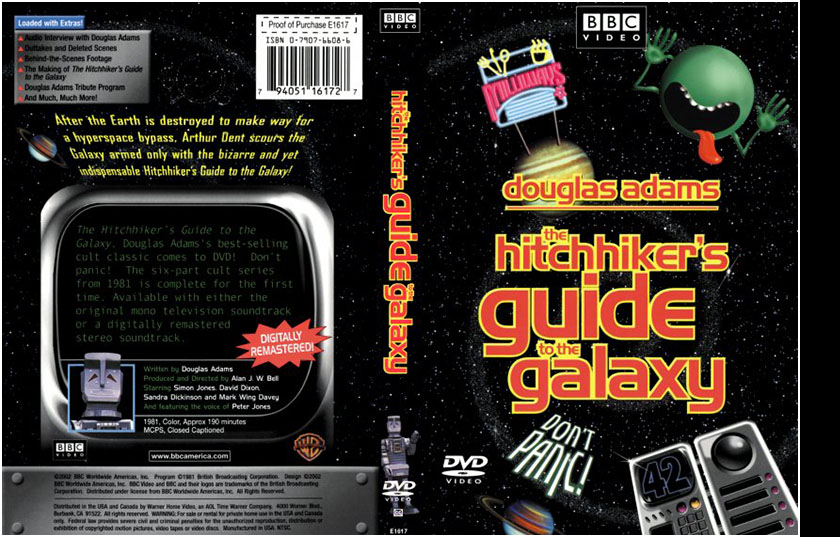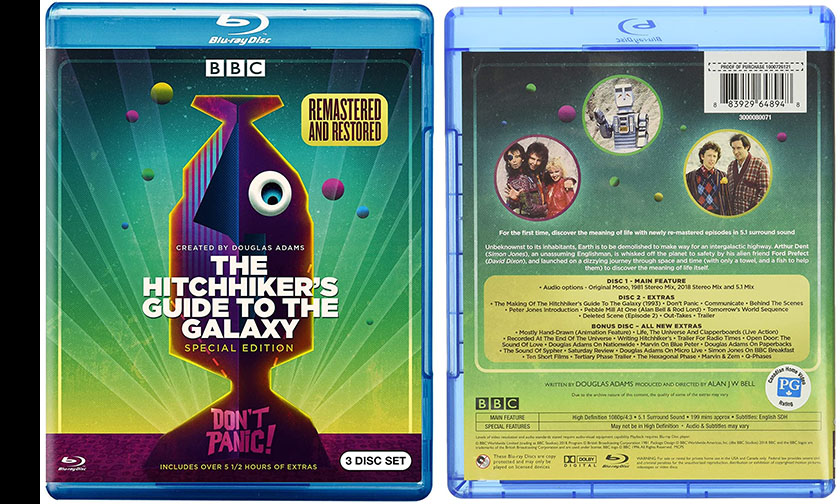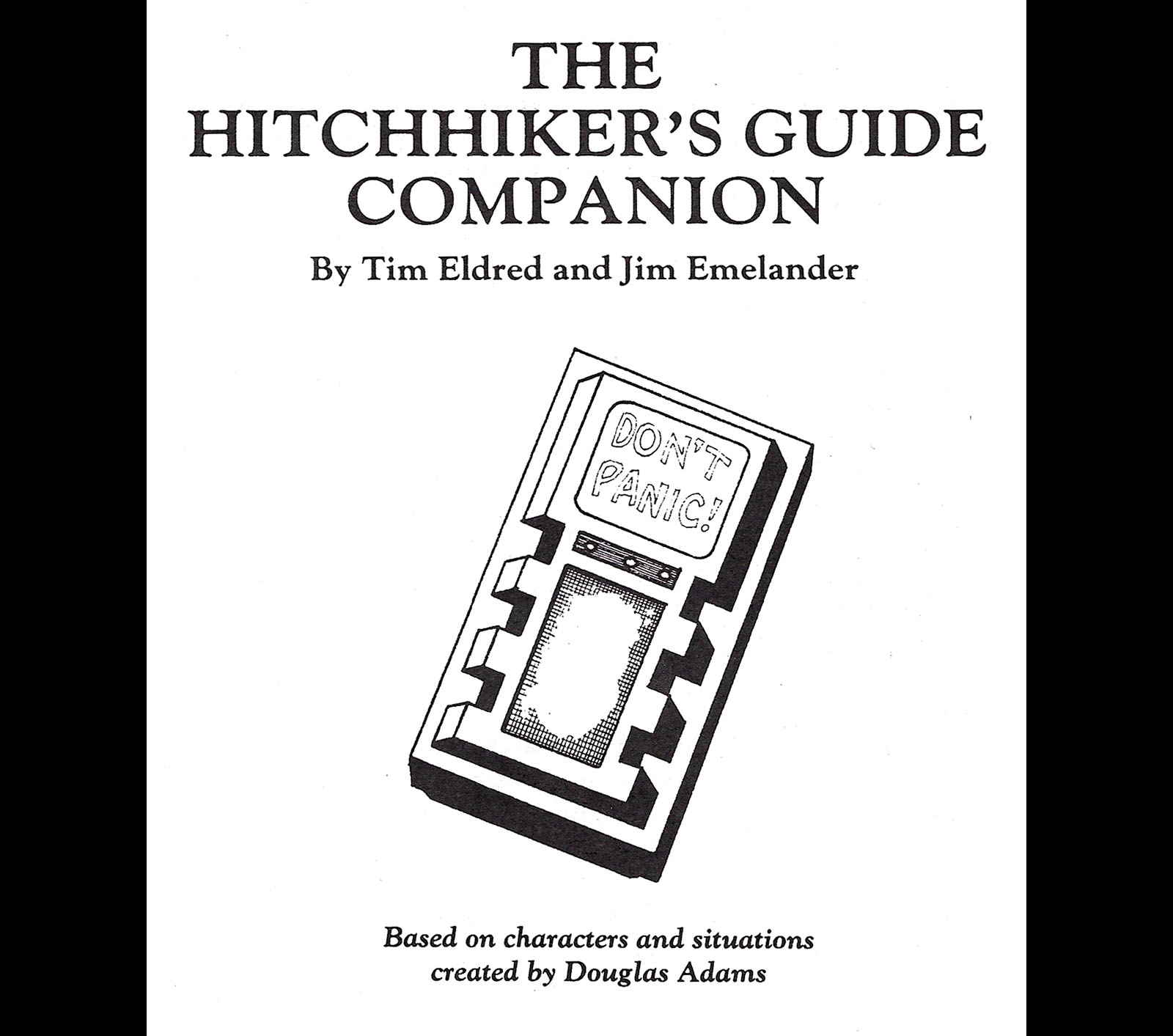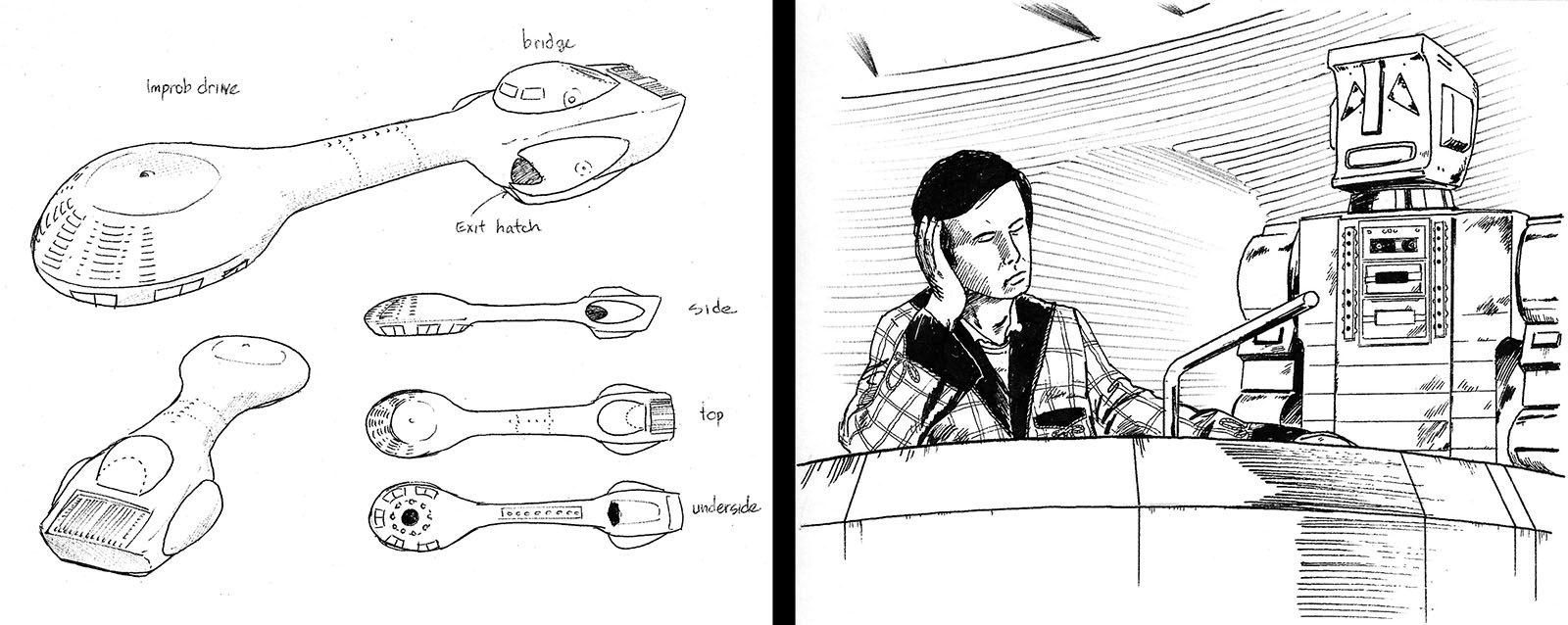The Hitchhiker’s Guide Companion, 1983
I’ve written elsewhere about the banner year 1982, when at the age of 17 I learned and discovered many of the things that would propel me into adult life and my dream career. One of those things was Douglas Adams’ eternally brilliant Hitchhiker’s Guide to the Galaxy. My entry point was the BBC radio series, introduced to me by a coworker at my summer job. He’d recorded every episode from NPR and loaned them to me for copying. By the end of that year, I’d memorized every word.
Following that I absorbed all the available books, the LPs, and every episode of the TV series when it debuted on PBS, either late ’82 or early ’83. And if you’ve learned anything about me by now, you know what this level of devotion leads to.
I’d been making headway in the world of SF fanzines for about a year by this time, and I thought someone really ought to create a Hitchhiker’s zine. Since nobody else seemed ready to dive in, my friend/collaborator Jim Emelander and I figured it was up to us.
When I decided to write this article, I invited Jim to throw in a word or two. To my delight, he pretty much wrote the entire thing for me. So I’ll turn it over to him and wedge in a comment where appropriate. Here he is…
First novel and the first three audiobooks I ever bought.
Tim asked me to write an introduction recounting my memories as to what went into creating the now legendary Hitchhiker’s Guide To The Galaxy Companion.
Now, the first thing I naturally did before putting text to Google Doc was something I’ve not done in years. I found my copy of the HHG Companion and read it cover to cover. When that was done, I looked at the publication date. Then I looked at the date again. Then like Authur Dent in the HHG Companion, I found myself suppressing a small shudder.
Forty years. How in the dingo’s kidneys had forty years passed since Tim and I sat in his room kicking around ideas for this loving work of fan fiction??? Gaarrrr.
Tim and I used to hang out a lot in the 80s. We both lived in Hudsonville, Michigan. It was a mostly rural community near the city of Grand Rapids. So rural, in fact, that I remember what a big deal it was when they put in a McDonalds near the expressway exit.
Most guys my age in Hudsonville were into sports, cars, 4H, church, cows, and girls. So, I’ll say this really started because I met Tim. The odds of finding another fanboy in Hudsonville was probably around 2,720 to 1 (Han…asteroids). It was fantastic to know someone who you could talk to about Star Wars, Trek, Star Blazers, movies, model-building, comics, and all other geek topics without that someone rolling their eyes. Those were our interests. It was like letting oxygen into an airless room.
Tim would later stumble across the Star Trek Club of Grand Rapids (STCOGR). More air. More lifelong friends. Introductions to things like fanzines, conventions, and a lot more cool geek stuff. Of course, one of our major interests became The Hitchhiker’s Guide To The Galaxy. This hilarious lampooning of our favorite genre filled with Pythonesque humor was easy to love. We loved it. Our growing circle of friends all loved it.
One problem though. There was not enough HHG material available. We had the books, which we of course had no idea would eventually become a five book trilogy (head pop). And, we had our local PBS television station running the 6-episode TV series, which we could watch once. After that, we had audio-only recordings because VCRs were still too expensive. Maybe on the other side of the pond there were fan magazines or other materials available, but in rural Hudsonville, that was that.
Or, that was that, until our local NPR radio station reran the HHG radio drama, which predates the books and the TV adaptation. It mostly follows the content of the first two books. Earth destroyed, Vogons, going to the restaurant, etc. In its second half, the radio drama starts differing…wildly… from the books. Characters get split up, new characters are introduced, new plots, and new goofy alien races appear. For example, Adams created a civilization where the populace evolved into bird people so they would no longer have to walk on their overly-polluted planet’s surface. We go over more of these changes in the HHG Companion‘s preface.
The radio series, expanded!
As I remember it, there were two things that really sparked the writing of this zine. The first was going to SF conventions and seeing nothing, nada, zip, zero in the way of HHG material. Not even fan fiction. We saw that as an open, barren market. The second, because we needed something to inspire us as a starting point, was a thunk. Or rather, the lack of a thunk.
The books and the radio series storylines start diverging shortly after Zaphod Beeblebrox goes into the Total Perspective Vortex. For those of you who don’t remember, the TPV was a torture chamber. You’re placed in the vortex chamber, and for one brief instant the whole of infinity is displayed. You are shown your size and relationship to it. As a result, you are driven mad by seeing yourself as an insignificant dot on an insignificant dot.
In both the book and the radio show, Zaphod is placed into a personal pocket universe (without his knowledge) before his encounter with the TPV. The pocket universe is an exact copy of the “real” universe. The only difference is that it was created for Zaphod. Because of this, the TPV determines him to be the single most important thing in all creation and tells him, “You’re a really great guy.”
The movie…wasn’t terrible. It could have been.
In the book, after the facts are explained to him, Zaphod hears an audible ‘thunk’ as the pocket universe shuts down and he’s restored to ‘normal’ reality. He’s told that he never would have survived the REAL Vortex. In the radio series there is no ‘thunk’ and no mention of the pocket universe being shut down. One would then have to assume that we’re still in the pocket universe. Probably an unintentional gap in the writing. However, it is after this where the stories start to split.
If Zaphod is still in the pocket universe, then all the events going forward in the radio drama are not in the book universe. One difference occurs quickly; in the radio drama, Zaphod surviving the Vortex was big news with reports making a big deal of it. We follow up with more on that in the HHG Companion.
The entire radio show, with its different story/characters/locations, was no longer a different version of the source material that needed to be fully polished before going into a book. It was an alternate HHG universe. It was as if this miniscule continuity error had been waiting there for Tim and myself to find and bend to our will. Bwahahaha!
You should definitely read these.
I wish I could remember which of us first had the idea to create a zine, but this is lost to me now. We both drew comics, but since visual ref from the TV series was hard to get, I don’t think we even considered going that way. We’d make it a prose zine with whatever illustrations we could cobble together. For one thing, that meant we could get it done a lot faster. I’m pretty sure it went from start to finish in just two or three months.
We started having writing sessions. We’d spitball ideas, put stuff down on paper, reject stuff, rewrite stuff, paste up pages, laugh at our own jokes, and generally have a good time creating. I expect some pizza was involved.
This being 1983, we didn’t have desktop publishing. I had a Commodore 64 and a really cheap-ass dot matrix printer. This type of crappy printing is how some fanzines at the time were printed. This wouldn’t do for our baby.
Tim’s indulgent mom agreed to take our typewritten pages and typeset them at her office. She provided us roll after roll of clear, professional-looking text. Typesetting involved a machine that would use light and templates to burn text onto photo-sensitive paper that then had to be chemically developed. Yeah. Different time, man.
You should ABSOLUTELY hear this!
At the SF convention where it was released (where fans tended to pick up anything and everything that wasn’t nailed down to a table) the HHG Companion was a smashing success. I don’t remember the size of the print run. 100 or 200, maybe? However, it was only $3.00 and it quickly sold out. We probably made…and I”m not exaggerating here…enough to buy each other a decent lunch at Wendy’s.
This was our first experience not only creating and producing our own fanzine, but also selling it. I still remember how awkward it was to make our first sale. We approached a guy wearing a HHG costume at a local SF convention, thinking he might be interested. We didn’t have a dealer’s table, so we literally had to show it to him in the trunk of Jim’s car. It felt like a drug deal. He bought it, though.
As far as specifics of who created what, Tim did most (probably all) of the illustration work. I may have over-inked some of it. I think the Zaphod song may have been mine. Fnirk the Quimbaloid was based on a yellow yarn ball alien with googly eyes and pipe cleaner legs/antenna that hung on the bulletin board in my bedroom, right next to a small picture of Charlie’s Angels. Other than that, I really can’t remember who contributed what idea where.
The Zaphod song (what there is of it) was based on The Hero’s Return, from Pink Floyd’s 1983 album The Final Cut.
If we only had this while we were writing in 1983.
And somehow, magically, a DVD player…
At the end of the zine we put in a line asking if there will ever be a second issue, and we answered it with a line lifted from the radio series: “Find out–if you can.” I did get one phone call from someone who had read the HHG Companion, loved it, and wanted to know if we were doing a second issue. I didn’t want to hurt his feelings, so I think I told him we were considering it.
But we weren’t. Either we were just too busy with other things, or didn’t feel like putting in the work any more. We saw a gap and we filled it. The end. I did have a germ of an idea for where the story would go next, however. I’ll plug that in below.
I once heard as well from someone (and this may be totally apocryphal) that a copy of the HHG Companion was shown to Douglas Adams, who gave it a thumbs up. I doubt he actually would have read it or anything, but if imitation is the sincerest form of flattery, Tim and I were certainly flattering the hell out of him. Maybe he saw it and just said something nice.
I just learned about this Blu-ray set! Thanks, fate!
So, please, look this zine over. It does have some funny bits, some that fall quite flat, and some in need of a serious rewrite. You can, however, tell from reading that Tim and Jim worked really hard on this homage to the works of Douglas Adams. 21-year old me and 61-year old me both hope you enjoy it.
Related links:
Hitchhiker’s Guide Wikipedia page
ZZ9 Plural Z Alpha fan club site
The computer game (play it for free!)
Read it in PDF format here
After you’ve read the thing, this will make some more sense…
My “germ of an idea” for the followup to this story was that Arthur Dent would take his vendetta against Zaphod Beeblebrox (who apparently ordered the destruction of Earth) to the Dalman-Saxville Shoe Corporation, and whoever else would listen. They’d begin a public media campaign of retribution, and the growing Zaphod-is-a-really-great-guy cult (ZIARGG?) would retaliate. Billions of dollars would be spent, the conflict would escalate, and as entire planets were going to war, Arthur and Zaphod would quietly bump into each other and talk it out and realize it was all a huge misunderstanding.
The meta-commentary would be about how people allow themselves to be divided and polarized once they invest in their opinions, willing to go to war rather than admit a mistake. Sound like any planet you know?

